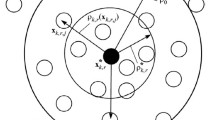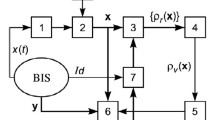Abstract
Biometric features used in recognition systems are subject to aging. In addition, there may be variations in working conditions that are not taken into account when registering a user. Therefore, one of the tasks that must be solved when building a universal and long-term functioning biometric system is updating the biometric template. An algorithm for updating a biometric template is proposed that uses an estimate of the distance from the presented biometric features to the user’s features registered under ideal conditions. Such an estimate is calculated by a neural network trained on a database with a large variability in registration conditions. The algorithm is tested on a face recognition system.



Similar content being viewed by others
REFERENCES
A. K. Jain and A. Ross, “Introduction to biometrics,” in Handbook of Biometrics, Ed. by A. K. Jain, P. Flynn, and A. Ross (Springer, Berlin, 2008), pp. 1–22.
A. Lantinis, “A survey of the effects of aging on biometric identity verification,” Int. J. Biometr. 2, 34–52 (2010).
N. Ramanathan and R. Chellappa, “Face verification across age progression,” IEEE Trans. Image Process. 15, 3349–3361 (2006).
A. Czajka, “Template ageing in iris recognition,” in Proceedings of the International Conference on Bio-inspired Systems and Signal Processing, Barcelona, Spain (2013), pp. 70–78.
S. Kirchgasser and A. Uhl, “Template ageing in non-minutiae fingerprint recognition,” in Proceedings of the 5th International Workshop Biometrics and Forensics, Coventry, UK, 2017, pp. 1–5.
G. Hasse and A. Wolf, “Data quality, interoperability, biometrics fusion, and template ageing: Challenges for epassports,” in Proceedings of the Biometric Consortium Conference, Arlington, VA, USA (2005).
J. Carls, R. Raines, M. Grimaila, and S. Rogers, “Biometric security enhancements through template aging matching score analysis,” in Proceedings of the 3rd International Conference on Information Warfare and Security, Omaha, NE, USA, 2008.
A. N. Gneushev, D. V. Kovkov, I. A. Matveev, and V. P. Novik, “Optimizing the selection of a biometric template from a sequence,” J. Comput. Syst. Sci. Int. 54, 399 (2015).
K. Hollingsworth, K. Bowyer, and P. Flynn, “Image averaging for improved iris recognition,” in Advances in Biometrics, Ed. by M. Tistarelli and M. Nixon, Lect. Notes Comput. Sci. 5558, 1112–1121 (2009).
B. Freni, G. L. Marcialis, and F. Roli, “Replacement algorithms for fingerprint template update,” in Proceedings of the International Conference on Image Analysis and Recognition (Springer, Berlin, 2008), pp. 884–893.
G. Lovisotto, S. Eberz, and I. Martinovic, “Biometric backdoors: A poisoning attack against unsupervised template updating,” in Proceedings of the IEEE European Symposium on Security and Privacy, Genova, Italy (2020), pp. 184–197.
G. L. Marcialis, A. Rattani, and F. Roli, “Biometric template update: An experimental investigation on the relationship between update errors and performance degradation in face verification,” in Structural, Syntactic, and Statistical Pattern Recognition, Ed. by N. da Vitoria Lobo, T. Kasparis, F. Roli, et al., Lect. Notes Comput. Sci. 5342 (2008).
U. Uludag, A. Ross, and A. Jain, “Biometric template selection and update: A case study in fingerprints,” Pattern Recogn. 37, 1533–1542 (2004).
A. Rattani, G. L. Marcialis, and F. Roli, “Biometric template update using the graph mincut algorithm: A case study in face verification,” in Proceedings of the IEEE Biometrics Symposium, Tampa, FL, USA (2008), pp. 23–28.
A. S. Georghiades, P. N. Belhumeur, and D. J. Kriegman, “From few to many: Illumination cone models for face recognition under variable lighting and pose,” IEEE Trans. Pattern Anal. Mach. Intell. 23, 643–660 (2001).
Y. LeCun, B. Boser, J. S. Denker, et al., “Handwritten digit recognition with a back-propagation network,” Adv. Neural Inform. Process. Syst. 2 (1989).
S. Chen, Y. Liu, X. Gao, and Zh. Han, “Mobilefacenets: Efficient CNNs for accurate real-time face verification on mobile devices,” in Proceedings of the Chinese Conference on Biometric Recognition (Springer, Cham, 2018), pp. 428–438.
InsightFace: 2D and 3D Face Analysis Project. https://github.com/deepinsight/insightface. Accessed November 8, 2021.
D. P. Kingma and J. Ba, “Adam: A method for stochastic optimization,” arXiv: 1412.6980 (2014).
Funding
This work was supported by the Russian Science Foundation, grant no. 20-01-00609.
Author information
Authors and Affiliations
Corresponding authors
Ethics declarations
The authors declare that they have no conflicts of interest.
Rights and permissions
About this article
Cite this article
Solomatin, I.A., Matveev, I.A. & Kubentaeva, S.B. Updating the Biometric Template by Assessing the Quality of the Original Data. J. Comput. Syst. Sci. Int. 61, 413–420 (2022). https://doi.org/10.1134/S106423072203008X
Received:
Revised:
Accepted:
Published:
Issue Date:
DOI: https://doi.org/10.1134/S106423072203008X




